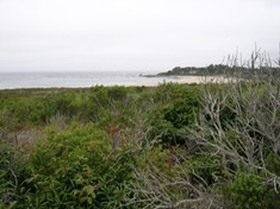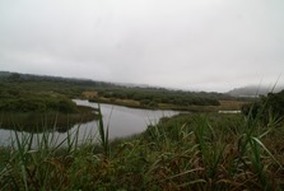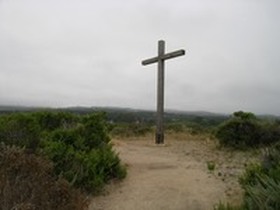
The Portola Cross overlooks the Carmel Bay. There is much history behind this area and the placing of the cross.
Sebastian Vizcaino in 1602 sailed from Mexico to what was known as Alta California. With him he took back reports of a large bay and natural harbor. Future colonization was thought to be suitable due to it’s seclusion and close sources of wood. The area had been mapped by Juan Cabrillo some 60 years before Viscaino’s visit. The latter provided more detail, as well as, some exaggerated reports of the area.
Not until 1768 did the Spanish get serious about colonizing Alta California. In this expedition it was planned to establish a presidio in San Diego and locate Monterey Bay and establish a presidio in the harbor by Viscaino. In the summer of 1769 Captain Don Gaspar de Portola and Father Juan Crespi along with a group of soldiers, natives, and mules headed north from San Diego. The San Jose, a supply ship from Mexico was to meet them when they reached Monterey Bay. What the land travelers did not know was the San Jose was lost. They came up the coast past what is now Morro Bay reached the Salinas River which they mistook for the Rio Del Carmelo that was described by Viscaino.
Sebastian Vizcaino in 1602 sailed from Mexico to what was known as Alta California. With him he took back reports of a large bay and natural harbor. Future colonization was thought to be suitable due to it’s seclusion and close sources of wood. The area had been mapped by Juan Cabrillo some 60 years before Viscaino’s visit. The latter provided more detail, as well as, some exaggerated reports of the area.
Not until 1768 did the Spanish get serious about colonizing Alta California. In this expedition it was planned to establish a presidio in San Diego and locate Monterey Bay and establish a presidio in the harbor by Viscaino. In the summer of 1769 Captain Don Gaspar de Portola and Father Juan Crespi along with a group of soldiers, natives, and mules headed north from San Diego. The San Jose, a supply ship from Mexico was to meet them when they reached Monterey Bay. What the land travelers did not know was the San Jose was lost. They came up the coast past what is now Morro Bay reached the Salinas River which they mistook for the Rio Del Carmelo that was described by Viscaino.
| The Carmel River was accurately described by Viscaino as being south of Monterey Bay. On October 1, 1769 upon arrival at the Salinas River the Portola-Crespi expedition believed they were still south of their destination. They continued north until they reached the San Francisco Bay. They realized they went too far north and turned back south. The travelers became aware that the information give by Vicaino was incorrect. They were unaware of the San Jose’s whereabouts and their provisions were running low. Unaware they had arrived at their destination, on November 28th, they stood on the shores of Monterey Bay. They camped for several days south of the bay near San Jose Creek, not knowing they were south of the Carmel River. |

The expedition decided to return to San Diego due to malnutrition and illness of the travelers. A large cross was put up to signal passing ships, in particular the San Jose on December 9th or 10th near the shore where they had set up their campsite. They engraved a message in the wooden cross to dig at the base where a message was placed in a container. In the message they explained they were headed back to San Diego and the dire situation they were in. They also erected a cross on the shore of the southeast side of Monterey Bay.
Potola and Crespi set out again in April of 1770. This time they had an understanding of their errors in navigation previously. They located Monterey on May 24 and discovered the second cross was still standing. Natives had place mussels at the base of the cross, arrows in the ground, and hung sardines from it with strings.
Father Junipero Serra arrived in Monterey on May 31st via the supply ship the San Antonio.
Learn more about this and many more historical events in the Monterey Bay area. Find out more at my website: SOC 902 Monterey: Historic Capital of California. Sign up for this course here.
Potola and Crespi set out again in April of 1770. This time they had an understanding of their errors in navigation previously. They located Monterey on May 24 and discovered the second cross was still standing. Natives had place mussels at the base of the cross, arrows in the ground, and hung sardines from it with strings.
Father Junipero Serra arrived in Monterey on May 31st via the supply ship the San Antonio.
Learn more about this and many more historical events in the Monterey Bay area. Find out more at my website: SOC 902 Monterey: Historic Capital of California. Sign up for this course here.


 RSS Feed
RSS Feed